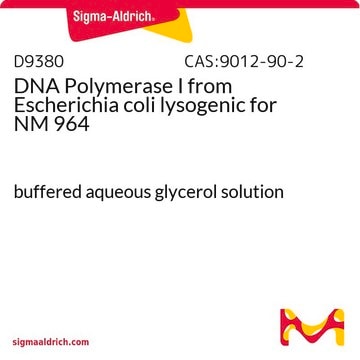11745808910
Roche
Nick Translation Mix
sufficient for 50 labeling reactions, pkg of 200 μL, solution
Synonim(y):
nick translation
About This Item
Polecane produkty
Postać
solution
Poziom jakości
zastosowanie
sufficient for 50 labeling reactions
opakowanie
pkg of 200 μL
producent / nazwa handlowa
Roche
metody
nucleic acid labeling: suitable
kolor
colorless
pH
~7.5 (68 °F)
rozpuszczalność
water: miscible
przydatność
suitable for fluorescent labeling techniques
suitable for molecular biology
Zastosowanie
genomic analysis
life science and biopharma
temp. przechowywania
−20°C
Powiązane kategorie
Opis ogólny
Individual templates produce consistent results in the standard 90-minutes reaction, and result in an average probe length of 200 base pairs up to 500 base pairs.
Assay Time: 100 minutes
Sample Materials
- Supercoiled and linearized plasmid DNA
- Supercoiled and linearized cosmid DNA
- Purified PCR products
Specyficzność
Zastosowanie
The Nick Translation Mix is designed for direct fluorophore-labeling of in situ probes. Fluorescein-12-dUTP and Tetramethyl-Rhodamine-5-dUTP from Roche Applied Science or other commercially available fluorophor-labeled nucleotides can be combined with the Nick Translation Mix. Direct fluorophore-labeled in situ probes are used for the detection of multi copy or very large hybridization targets on metaphase chromsomes or interphase nuclei.
For a standard labeling reaction using 1 μg template in 20 μl total reaction volume, 4 μl of 5x concentrated fluorophore labeling mix are required.
Komponenty
1 vial with 5x concentrated solution, stabilized reaction buffer in 50% glycerol (v/v), DNA Polymerase I and DNase I.
Jakość
Zasada
E. coli DNA Polymerase I synthesizes DNA complementary to the intact strand in a 5′?3′ direction using the 3′-OH termini of the nick as a primer. The 5′?3′ exonucleolytic activity of DNA polymerase I simultaneously removes nucleotides in the direction of synthesis. The polymerase activity sequentially replaces the removed nucleotides with isotope-labeled or hapten-labeled deoxyribonucleoside triphosphates. At low temperature (+15°C), the unlabeled DNA in the reaction is thus replaced by newly synthesized labeled DNA.
Przechowywanie i stabilność
Inne uwagi
Denaturing of the template before nick translation is not required.
Kod klasy składowania
12 - Non Combustible Liquids
Klasa zagrożenia wodnego (WGK)
WGK 1
Temperatura zapłonu (°F)
does not flash
Temperatura zapłonu (°C)
does not flash
Certyfikaty analizy (CoA)
Poszukaj Certyfikaty analizy (CoA), wpisując numer partii/serii produktów. Numery serii i partii można znaleźć na etykiecie produktu po słowach „seria” lub „partia”.
Masz już ten produkt?
Dokumenty związane z niedawno zakupionymi produktami zostały zamieszczone w Bibliotece dokumentów.
Klienci oglądali również te produkty
Nasz zespół naukowców ma doświadczenie we wszystkich obszarach badań, w tym w naukach przyrodniczych, materiałoznawstwie, syntezie chemicznej, chromatografii, analityce i wielu innych dziedzinach.
Skontaktuj się z zespołem ds. pomocy technicznej







